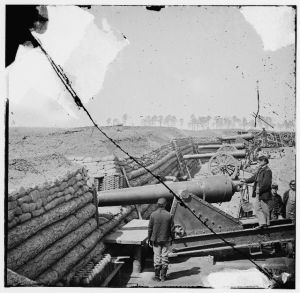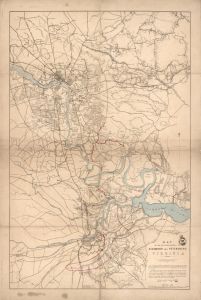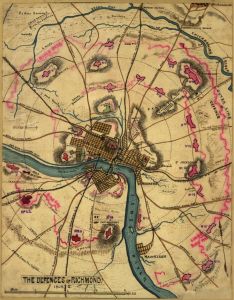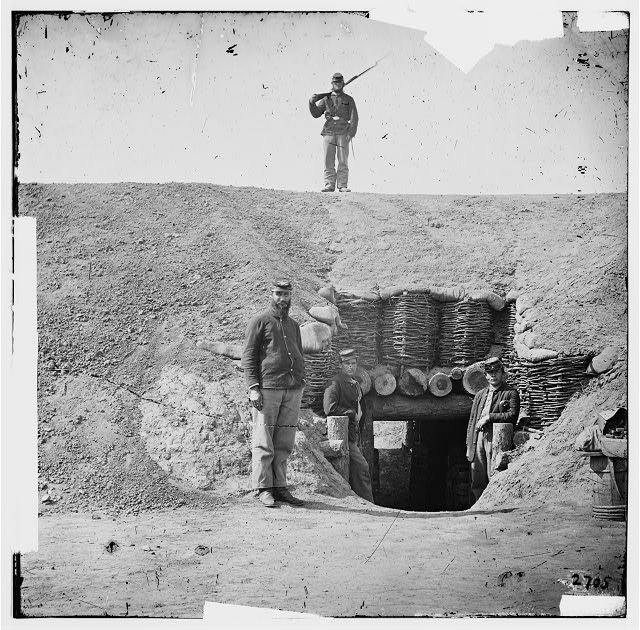150 years ago today editors in Richmond mentioned that the Union army might be sending some incendiary shells their way in the near future. From the Richmond Daily Dispatch December 5, 1864:
The preparations for shelling Richmond — experiments with the incendiary shell — news from below the city.
The Yankees seem to be preparing for the experiment of shelling Richmond.–The shells are invented by A. Berney, and contain the celebrated Greek fire, which has been tried at Charleston. A letter to the Tribune, speaking of the experiments with this projectile, says:
The day before yesterday some highly interesting experiments were made from Fort Brady, at the left of our lines on this side of the James, with an incendiary shell, which. I believe, bears the name of its inventor, Mr. A. Berney, of the Greek fire notoriety. One hundred pound shells were fired from our battery, under charge of Captain H. H. Pierce, of the First Connecticut artillery. Five frame houses, distance nearly a mile, were successively fired and burned to the ground. The cellar of one of these had, it appeared, been used as a sort of magazine, as shells exploded extensively during its conflagration.

“Fort Brady, Va. Battery of Parrott guns manned by Company C, 1st Connecticut Heavy Artillery” 1864 (Library of Congress)
To-day another trial was undertaken. A few ordinary shells were sent over to the “Johnnies,” however, with the compliments of Captain Pierce, and one of the incendiary fellows was exploded in closer proximity to a large house in the rebel lines, in full view of our battery, but not near enough to it to accomplish its ignition. We succeeded, however, in drawing the fire from all of the three batteries which the rebels have been so busily engaged in planting across the James for some weeks past, twelve guns in all, and they poured the shell very lively, for near two hours, into Fort Brady. We have elicited this fact: that they have 7 and 8 inch Brooks’s guns, 10 inch columbiads and Whitworth guns mounted over there, and that is about all, except that we can fire any building, or collection of buildings, which is within range of our guns.
In this connection, it is interesting to state that every house in Petersburg lies in easy reach of our works, and that we also posses guns which are able, from our advanced position, to reach the very heart of the city of Richmond. It will thus be seen what we can do, and it may be my province hereafter to state either what we will do, or have already done, toward causing the rebels to feel the hardships of war.

“Map of the neighbourhood of Richmond and Petersburg, Virginia.” 1864 (http://www.loc.gov/item/97684234/)
The other day a distinguished party called on General Butler, consisting of General Grant, Meade, Crawford, Warren, and a number of stars of lesser magnitude, and while here of course paid a visit to Dutch gap. While there a shell sent by the rebels exploded so near that fragments of one of them fell in the midst of the party, but luckily without injury to any one of its distinguished members.
The iron clads in the James river have been provided with a large-sized locomotive lantern, which is placed on the bow; and its rays, thrown ahead on the water, enable the men to see if the rebels send down infernal machines, or make any attempts to board them.
The map of the Richmond – Petersburg area “Shows confederate and federal positions as of December, 1864.” The federal positions are in red and Fort Brady would be near Cox’s Landing and Dutch Gap on the northeastern side of the James. Fort Brady is currently part of a Richmond Battlefield Tour from the National Park Service: “Fort Brady, a well-preserved fortification on the James River, was built by Union engineers after the battles of late September, 1864. It kept Confederate gunboats bottled up to the north, and anchored the Union line that extended to Fort Harrison and beyond”.
You can read about how the powder magazine was constructed here.


